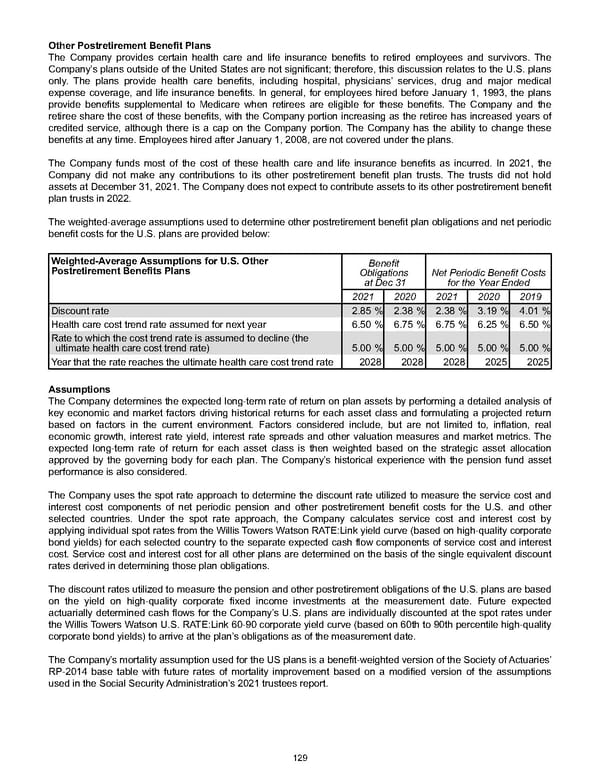Other Postretirement Benefit Plans The Company provides certain health care and life insurance benefits to retired employees and survivors. The Company’s plans outside of the United States are not significant; therefore, this discussion relates to the U.S. plans only. The plans provide health care benefits, including hospital, physicians’ services, drug and major medical expense coverage, and life insurance benefits. In general, for employees hired before January 1, 1993, the plans provide benefits supplemental to Medicare when retirees are eligible for these benefits. The Company and the retiree share the cost of these benefits, with the Company portion increasing as the retiree has increased years of credited service, although there is a cap on the Company portion. The Company has the ability to change these benefits at any time. Employees hired after January 1, 2008, are not covered under the plans. The Company funds most of the cost of these health care and life insurance benefits as incurred. In 2021 , the Company did not make any contributions to its other postretirement benefit plan trusts. The trusts did not hold assets at December 31, 2021 . The Company does not expect to contribute assets to its other postretirement benefit plan trusts in 2022 . The weighted-average assumptions used to determine other postretirement benefit plan obligations and net periodic benefit costs for the U.S. plans are provided below: Weighted-Average Assumptions for U.S. Other Postretirement Benefits Plans Benefit Obligations at Dec 31 Net Periodic Benefit Costs for the Year Ended 2021 2020 2021 2020 2019 Discount rate 2.85 % 2.38 % 2.38 % 3.19 % 4.01 % Health care cost trend rate assumed for next year 6.50 % 6.75 % 6.75 % 6.25 % 6.50 % Rate to which the cost trend rate is assumed to decline (the ultimate health care cost trend rate) 5.00 % 5.00 % 5.00 % 5.00 % 5.00 % Year that the rate reaches the ultimate health care cost trend rate 2028 2028 2028 2025 2025 Assumptions The Company determines the expected long-term rate of return on plan assets by performing a detailed analysis of key economic and market factors driving historical returns for each asset class and formulating a projected return based on factors in the current environment. Factors considered include, but are not limited to, inflation, real economic growth, interest rate yield, interest rate spreads and other valuation measures and market metrics. The expected long-term rate of return for each asset class is then weighted based on the strategic asset allocation approved by the governing body for each plan. The Company’s historical experience with the pension fund asset performance is also considered. The Company uses the spot rate approach to determine the discount rate utilized to measure the service cost and interest cost components of net periodic pension and other postretirement benefit costs for the U.S. and other selected countries. Under the spot rate approach, the Company calculates service cost and interest cost by applying individual spot rates from the Willis Towers Watson RATE:Link yield curve (based on high-quality corporate bond yields) for each selected country to the separate expected cash flow components of service cost and interest cost. Service cost and interest cost for all other plans are determined on the basis of the single equivalent discount rates derived in determining those plan obligations. The discount rates utilized to measure the pension and other postretirement obligations of the U.S. plans are based on the yield on high-quality corporate fixed income investments at the measurement date. Future expected actuarially determined cash flows for the Company’s U.S. plans are individually discounted at the spot rates under the Willis Towers Watson U.S. RATE:Link 60-90 corporate yield curve (based on 60th to 90th percentile high-quality corporate bond yields) to arrive at the plan’s obligations as of the measurement date. The Company’s mortality assumption used for the US plans is a benefit-weighted version of the Society of Actuaries’ RP-2014 base table with future rates of mortality improvement based on a modified version of the assumptions used in the Social Security Administration’s 2021 trustees report. 129
 Annual Report Page 138 Page 140
Annual Report Page 138 Page 140